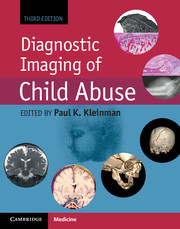Book contents
- Frontmatter
- Dedication
- Contents
- List of Contributors
- Editor’s note on the Foreword to the third edition
- Foreword to the third edition
- Foreword to the second edition
- Foreword to the first edition
- Preface
- Acknowledgments
- List of acronyms
- Introduction
- Section I Skeletal trauma
- Section II Abusive head and spinal trauma
- Section III Visceral trauma and miscellaneous abuse and neglect
- Section IV Diagnostic imaging of abuse in societal context
- Section V Technical considerations and dosimetry
- Chapter 28 Radiologic image formation: physical principles, technology, and radiation dose considerations
- Chapter 29 The physics and biology of magnetic resonance imaging: medical miracle anyone?
- Chapter 30 Quality assurance and radiographic skeletal survey standards
- Index
- References
Chapter 28 - Radiologic image formation: physical principles, technology, and radiation dose considerations
from Section V - Technical considerations and dosimetry
Published online by Cambridge University Press: 05 September 2015
- Frontmatter
- Dedication
- Contents
- List of Contributors
- Editor’s note on the Foreword to the third edition
- Foreword to the third edition
- Foreword to the second edition
- Foreword to the first edition
- Preface
- Acknowledgments
- List of acronyms
- Introduction
- Section I Skeletal trauma
- Section II Abusive head and spinal trauma
- Section III Visceral trauma and miscellaneous abuse and neglect
- Section IV Diagnostic imaging of abuse in societal context
- Section V Technical considerations and dosimetry
- Chapter 28 Radiologic image formation: physical principles, technology, and radiation dose considerations
- Chapter 29 The physics and biology of magnetic resonance imaging: medical miracle anyone?
- Chapter 30 Quality assurance and radiographic skeletal survey standards
- Index
- References
Summary
Introduction
In this chapter certain fundamental aspects of radiologic image formation and technologies that are important for understanding the role of each imaging modality on the evaluation of suspected child abuse are described. The emphasis will be on x-ray imaging including digital radiography (DR), fluoroscopy, and computed tomography (CT), but the technologic aspects of nuclear imaging such as planar, single photon emission tomography (SPECT), and positron emission tomography (PET) will also be discussed from the technologic and radiation dose point of view. Certain basic aspects of ultrasonography will be presented especially on how it relates to x-ray and nuclear imaging techniques. Magnetic resonance imaging (MRI) is covered in a separate chapter (see Chapter 29). This chapter is intended to provide an accurate description of the physics and engineering behind these imaging technologies that can be easily appreciated by nonradiologists, radiologists, and other health care providers who need to make decisions on the appropriate imaging procedure.
In recent years, medical imaging has undergone a dramatic transformation in the development of imaging hardware, software, and image acquisition techniques. Diagnostic imaging information, previously thought to be unattainable, is now a reality. This has resulted in an overall information yield and accuracy hitherto not imagined, and in a dramatic decrease in the number of surgical exploratory and treatment procedures. However, this rapid evolution has created disconnects between the capabilities of the techniques, their appropriate implementation, and full understanding by the referring physicians. As technology has evolved in capability and complexity, ordering the appropriate imaging test has become increasingly challenging. In view of the recent highly publicized concerns about radiation to children from medical imaging procedures, particularly from CT, selecting the appropriate imaging test requires careful consideration of the alternatives, including techniques that use the least amount of radiation (1–6). At this juncture, it is important for clinicians to have at least a basic understanding of the fundamental principles and the technology behind every imaging test.
- Type
- Chapter
- Information
- Diagnostic Imaging of Child Abuse , pp. 667 - 687Publisher: Cambridge University PressPrint publication year: 2015
References
- 1
- Cited by

